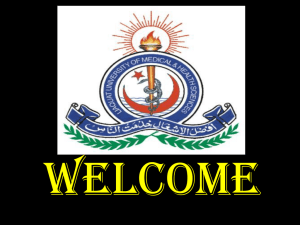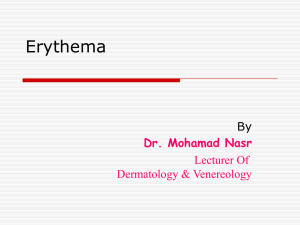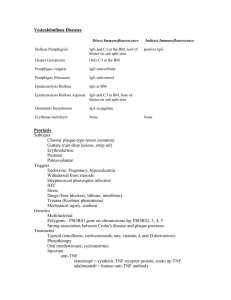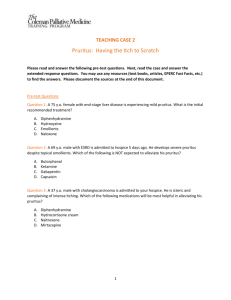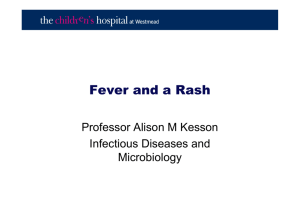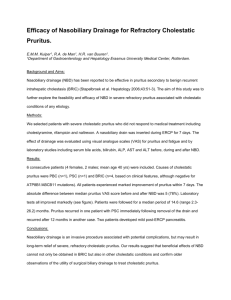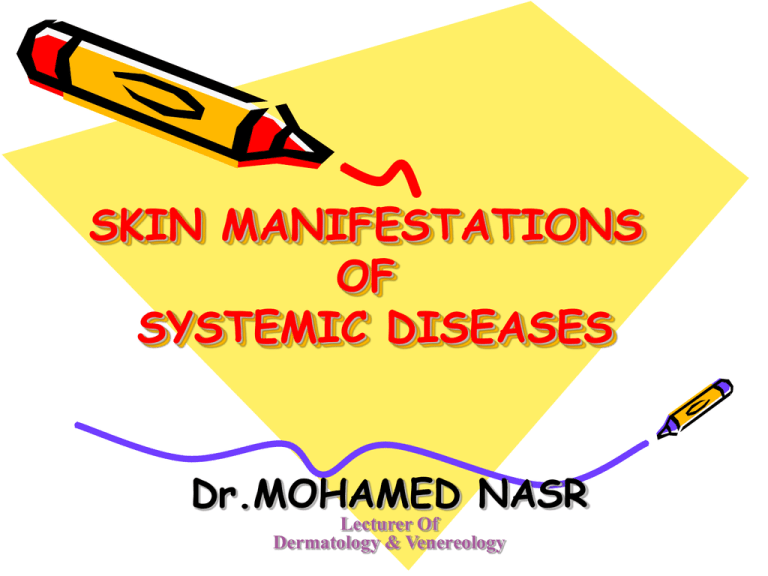
SKIN MANIFESTATIONS
OF
SYSTEMIC DISEASES
Dr.MOHAMED NASR
Lecturer Of
Dermatology & Venereology
The relation between skin and the body is
three dimensional:
A-Effect of skin on the body:
B-Diseases affecting both the skin and body:
C-Skin as a mirror of the systemic diseases:
A-Effect of skin on the body:
Extensive burns
Erythroderma
Bullous diseases
Electrolyte
imbalance
Hypoproteinaemia
Hypothermia
Massive
sepsis
B-Diseases affecting both the skin
and body:
- Connective tissue diseases:
1- Systemic lupus erythematosis
2- Systemic sclerosis
3- Dermatomyositis
- Hereditary diseases:
e.g neurofibromatosis (Von Reckling
Housen's disease).
C-Skin as a mirror of the systemic diseases:
1-Thyroid disease
Both hyper and hypothyroidism are associated
with characteristic skin manifestations.
Hyperthyroidism
Warm skin, flushing, palmar erythema and
increased sweating (palms and soles).
Fine thin hair and sometimes diffuse alopecia.
Plummers nails and thyroid acropachy.
Hyperpigmentation.
Pretibial myxedema.
Pruritus , urticaria.
Fine thin hair
Flushing
Plummers nails
Thyroid acropachy
Black
halos
Pretibial
myxedema
Hypothyroidism
Pale cold ivory yellow scaly wrinkled skin.
Absent sweating, dry skin (xerosis).
Eczema and pruritus.
Palmoplantar keratoderma.
Xanthomatosis.
Puffy oedema of hands, face and eyelids.
Purpura and ecchymoses.
Punctuate telangiectasia on arms and fingertips.
Delayed wound healing.
Brittle striated nails and slow nail growth.
Coarse sparse scalp hair.
Loss of axillary and facial hair.
xerosis
Palmoplantar
keratoderma
Xanthomatosis
2-Diabetes mellitus:
Diabetic dermopathy is the most common manifestation
(brownish depressed spots on the shins, forearms, thigh and
over bony prominences ).
Erysipelas like erythema on the legs or feet in elderly diabetics.
Diabetic rubeosis of face , hands and feet.
Recurrent cutaneous infections (bacterial ex; Staph and fungal
ex; candidiasis).
Diabetic bullae and wet gangrene.
Diabetic microangiopathy.
Diabetic neuropathy.
Trophic ulcers and diabetic foot.
Pruritus especially perianal and genital regions.
Skin manifestations associated with diabetes:
--Necrobiosis lipoidica (pretibial yellowish smooth
firm atrophic plaque with erythematous border
and telangiectasia on the surface)
--Dessiminated granuloma annulare
--Eruptive xanthomas
Diabetic dermopathy
Necrobiosis lipoidica
Dessiminated granuloma annulare
3- Gastrointestinal diseases:
a-Acrodermatitis enteropathica:
Probably caused by an inherited defect in the
absorption of zinc leading to acute zinc deficiency,
usually at the time of weaning.
The child becomes photophobic, irritable or
withdrawn and may suffer from diarrhea.
Vesiculobullous dermatitis, periorificial and on hands
and feet.
Loss of scalp hair, stunted growth and higher
incidence of infection.
Poor wound healing.
b-Ulcerative colitis:
Skin lesions occur in 10% - 30% of patients with
ulcerative colitis;
pyoderma gangrenosum
erythema nodosum
erythema multiforme
aphthus stomatitis
urticaria & angioedema
vascultitis, purpura and gangrene.
4- Liver disease:
Generalized pruritus: due to bile salts, endogenous opiates
Pigmentation:
– jaundice
– muddy grey hyperpigmentation with yellowish tinge
– spotted hypomelanosis in relation to spider angiomas
Spider angiomas and caput medusae
Palmar erythema
Purpura and bruises
Thin hair, female type of hair distribution in males and loss of
secondary sex characters (effect of hormonal disturbance)
Terry's nails ( diffuse white colour of the nail plate with distal
pink colour), white bands, clubbing & koilonychia
Lichen planus
Spider angioma
Caput medusae
Palmar erythema
Terry’s nail
5- Chronic renal failure (uraemia)
Muddy brown or grey skin colouration (earthy
look).
Pallor due to reduced erythropoesis and increased
haemolysis.
Dry skin with urea frost and generalised intense
pruritus.
Half and half nails (the distal part of nail plate is
reddish brown while the proximal part is white).
Purpura, calcification and perforating dermatoses.
Urea frost
Half and half nail
6- Paraneoplastic lesions
They are skin diseases or manifestations which
have higher incidence with malignancies.
Lesser Trélat sign; sudden development of
numerous
seborrheic
keratoses
with
adenocarcinoma of GIT and breast.
Pyoderma gangrenosum; with lymphomas,
leukemias, multiple myeloma.
Dermatomyositis; with gynecological
tumors in women & lung cancer in men.
Acanthosis nigricans with GIT tumors.
Acanthosis palmaris; with bronchogenic
carcinoma.
Palmoplantar keratoderma with carcinoma of
the eosophagus.
Acquired icthyosis; with lymphomas.
Pruritis with Hodgkin lymphoma.
Flushing with carcinoid syndrome.
Erythroderma; with Sézary syndrome,
lymphomas and leukemias.
Erythema annulare centrifugum with
myeloproliferative disorders.


